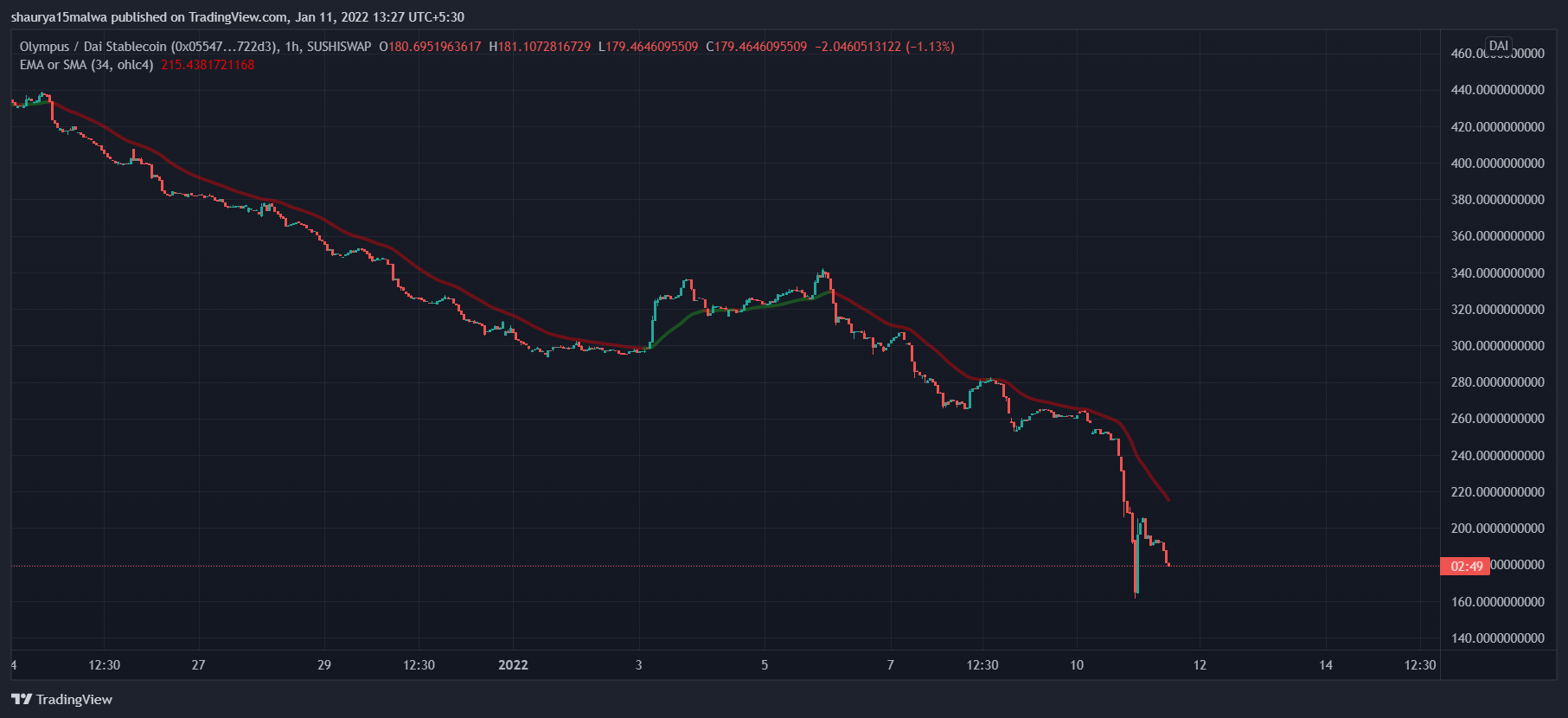Olympus tanks 30% led by liquidations on fuse, souring market sentiment
|
Tokens of decentralized finance (DeFi) protocol Olympus (OHM) dropped as much as 32% in the past 24 hours as crypto traders moved away from experimental Defi projects amid an overall negative sentiment in the crypto market.
OHM fell from Monday’s peak of $264 to $161 during the early Asian hours on Tuesday, reaching lows previously seen in May 2021. The move was part of a larger downtrend since October 2021 highs of $1,360, when the protocol reached a market capitalization of $4 billion. As of Tuesday, OHM prices are down 87% from all-time highs.
Olympus, like other DeFi projects, relies on smart contracts instead of intermediaries to provide financial services to users. Its goal is to create a stablecoin backed by crypto instead of fiat currencies like the U.S. dollar, which users can in turn stake for currently offered annualized returns of 7,800%.
Users are incentivized to deposit or sell their OHM collaterals in return for discounted OHM sold by bonds issued by Olympus. This is said to create “protocol-owned liquidity,” as the user-issued liquidity provider (LP) tokens are tied back to the bonds issued by Olympus, creating a continuous loop of supply and demand.
Fuse liquidations contribute to OHM fall
Analysts said a popular pool to leverage returns on OHM tokens saw overnight liquidations which contributed to the price drop.
“People who employed the leveraged OHM strat (9,9) by borrowing from Fuse got liquidated,” explained Ashwath Balakrishnan, VP of research at Delphi Digital, in a Telegram message to CoinDesk.
Fuse is an interest rates product by Rari Capital, a DeFi protocol that provides yield-earning services to users. Fuse lets users create their customized pool consisting of various interest-earning tokens, allowing other users to stake their own tokens on such pools and earn yields.
The rather risky Pool #18 on Fuse is focused on Olympus, locking up over $101 million across OHM and right other cryptocurrencies. The pool takes OHM staking a step ahead for users: unlike staking OHM on Olympus, staking OHM on Fuse allows users to borrow cryptocurrencies against their OHM holdings while continuing to earn interest on the staked OHM. This allows users to access liquidity without having to sell their OHM rewards and missing out on potential gains.
However, such borrowing features come with their drawbacks. Holdings are automatically liquidated when prices of underlying tokens fall below a certain level, as the Fuse protocol needs to maintain the collateral’s monetary position.
Sell-offs in the open market lead to falling prices, which in turn lead to further sell-offs by token holders who may want to take profits on their positions. This creates a cascading event that contributes to drastic price drops, one that OHM saw in the past 24 hours.
Information on these pages contains forward-looking statements that involve risks and uncertainties. Markets and instruments profiled on this page are for informational purposes only and should not in any way come across as a recommendation to buy or sell in these assets. You should do your own thorough research before making any investment decisions. FXStreet does not in any way guarantee that this information is free from mistakes, errors, or material misstatements. It also does not guarantee that this information is of a timely nature. Investing in Open Markets involves a great deal of risk, including the loss of all or a portion of your investment, as well as emotional distress. All risks, losses and costs associated with investing, including total loss of principal, are your responsibility. The views and opinions expressed in this article are those of the authors and do not necessarily reflect the official policy or position of FXStreet nor its advertisers.
